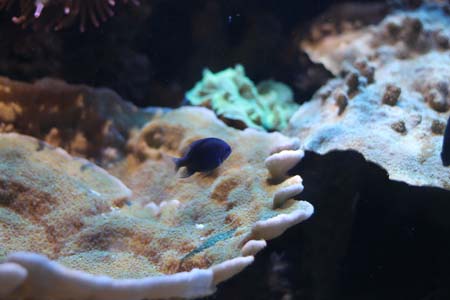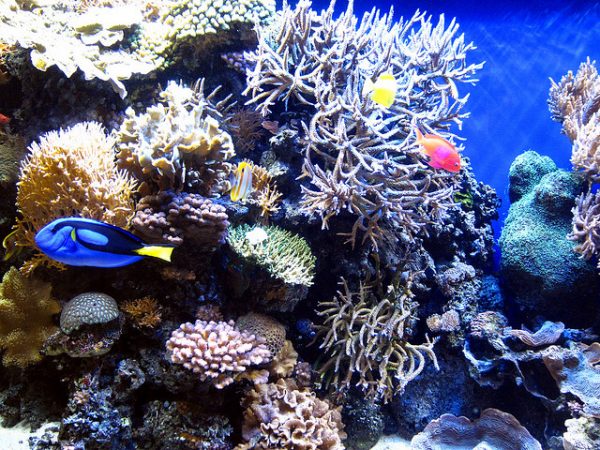What is an SPS Coral?
 SPS coral is the name given to the group of coral species that have a stony calcium carbonate skeleton with tiny coral polyps. These corals are generally the first that comes to mind when someone joins the reef aquarium hobby, sometimes called the ‘true’ corals because they are the corals that build the backbone of the reefs. But even though an SPS coral tank may be the first thing thought of, they are often the last coral species to be mastered.
SPS coral is the name given to the group of coral species that have a stony calcium carbonate skeleton with tiny coral polyps. These corals are generally the first that comes to mind when someone joins the reef aquarium hobby, sometimes called the ‘true’ corals because they are the corals that build the backbone of the reefs. But even though an SPS coral tank may be the first thing thought of, they are often the last coral species to be mastered.
The most commonly available SPS coral species are the “pora’s”
- Acropora
- Montipora
- Pocillopora
- Seriatopora
- Porites
Proper care
Just like with the LPS coral species, it is dangerous to provide generalizations about the care for a group as large and unscientific as SPS coral, because not all the species from every genus fit into the generalizations that could be made. According to Borneman, in his authoritative tome Aquarium Corals, there is no real correlation between polyp size, where a coral lives in the reef and how you can effectively care for them in a saltwater aquarium. Although imperfect and general, we have to start somewhere, and I thought it would be better to provide some initial direction here and then encourage you to seek out specific information for the SPS coral species you are interested in keeping.
 Small polyp stony corals have a calcified external skeleton, so it is essential to monitor and control for alkalinity, dissolved calcium and magnesium levels. Insufficient levels of calcium will result in erosion of the skeleton and eventually death of the organism and low magnesium will cause low levels of calcium. In order to successfully keep SPS corals, you will probably have to add a calcium supplement to your regular water changes with a high-quality reef salt mix that already has a high concentration of calcium and magnesium.
Small polyp stony corals have a calcified external skeleton, so it is essential to monitor and control for alkalinity, dissolved calcium and magnesium levels. Insufficient levels of calcium will result in erosion of the skeleton and eventually death of the organism and low magnesium will cause low levels of calcium. In order to successfully keep SPS corals, you will probably have to add a calcium supplement to your regular water changes with a high-quality reef salt mix that already has a high concentration of calcium and magnesium.
Water flow is an important aspect to consider with the care of SPS corals. Generally speaking, the thicker and sturdier the branches, the more flow the corals need to grow. Make sure you have some powerful turbulent flow to keep these corals healthy.
Testing
While there may be a few exceptions to the rule that would allow you to stray a bit from the ideal water parameters, if you want to keep SPS coral species, you would be best served to maintain pristine water parameters. Ammonia, Nitrites, and Nitrates should be zero. Calcium should be more than 400 ppm, Magnesium 1300 ppm.
To determine how much calcium your SPS corals need, the best thing to do is measure the calcium levels on a routine basis at the same time each day, for several days between water changes. Over a few days, the calcium levels in your tank should drop, as the SPS corals and LPS corals in your tank pull the calcium out of the water to make their skeletons. Tracking this, over time, will tell you your calcium depletion rate, which in turn will tell you how much calcium you need to add to the tank in between water changes.
Light
For the most part, SPS corals require fairly strong light. High power reef LEDs, metal halide and T5 lights are generally used to grow these corals. According to Borneman, 12 hours on and 12 hours off is a pretty straightforward recommended duration for most lighting systems.
Feeding
SPS corals are generally photosynthetic, depending on their zooxanthellae to convert light energy into food, like plants and algae. But unlike plants and algae, SPS corals are also able to capture and eat tiny prey with their polyps. The size of the polyps dictates the size of the food they can eat. You should target-feed your SPS coral with Cyclops, marine snow or other small zooplankton.
prey with their polyps. The size of the polyps dictates the size of the food they can eat. You should target-feed your SPS coral with Cyclops, marine snow or other small zooplankton.
How to frag an SPS coral
An excerpt from How to Frag Corals
At the top of the food chain (not literally, but as far as status in the aquarium hobby goes…) are the Small Polyp Stony Corals (SPS) Acropora species, Birdnest (Seriatopora hystrix), Montipora capricornis or verrucosa (plate), Montiopora digitata (branched), and Poccilopora damicornis.
Fragging techniques
Fragging these corals tends to be fairly straightforward. As the name small Polyp Stony implies, these corals have small polyps (which means they aren’t large, fleshy and prone to injury like the Large Polyp Stony Corals), and a stony skeleton. The best approach is to use bone cutters with the Snapping method to snap off a piece. This works especially well for thinly branched corals like Birdnest or Montipora Plate Corals. If you don’t have a good pair of cutters, you could use the Sawing method to zip through one of the branches.
I like using bone cutters and the Snapping method. It feels like pruning a tree. Using the rotary tool just feels a bit more intense, although it arguably makes cuts very well.
Attachment techniques
As is the case for the rest of the Stony Corals, attachment is fairly simple; all you need is a frag plug or rock and some cyanoacrylate glue to attach these corals with the Glue method. Each of these techniques is covered in more detail in How to Frag Corals.
Parasites
One of the perennial challenges in this hobby is to keep disease and parasites out of the tank–because once they get in, it can be excruciatingly painful to get them back out. Red bugs, black bugs, and parasitic copepods are some of the more common and damaging parasites that affect SPS coral.
Here are two articles to help you become an expert about SPS coral parasites:
Beginner SPS corals
If you are new to the hobby, I strongly recommend you get some experience caring for other corals first, before diving head-first into an SPS dominated tank. With that said, there are a few species that are considered a bit easier to care for than some others. Check out these beginner SPS corals if you want to get started on the stony side of the hobby:
- Pavona
- Pocillopora
- Bird’s nest coral–seriatopora
- Montipora plating coral
In addition to selecting one of the above species–another strongly recommended approach is to buy captive-grown corals locally, to minimize damage from transportation and ensure you are picking a coral specimen that is already thriving in the aquarium.
Placing new specimens
Since you will likely have a high-powered light over your aquarium, you want to avoid shocking the coral–so unless you are confident that you can reasonably recreate the lighting level the coral was acclimated to in its previous home (a friend’s house or at the local fish store), you will want to start the coral in a relatively less intense lighting area and ease them into the permanent home, otherwise, you could cause that coral to bleach. Here is an article for you to read up on about photo acclimation.
Want to learn more?
If you want to continue learning more about SPS coral species, I recommend you check out these other resources:
Montipora is a great all-around coral
Written by Albert B. Ulrich III–author of The Reef Aquarium Series of books: The New Saltwater Aquarium Guide, How to Frag Corals, 107 Tips for the Marine Reef Aquarium
Follow Al’s board SPS Coral on Pinterest.


Leave a Reply